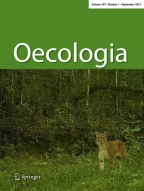Summary
The effects of CO2 enrichment and water stress on gas exchange of Liquidambar styraciflua L. (sweetgum) and Pinus taeda L. (loblolly pine) seedlings were examined for individuals grown from seed under high (1000 μmol·m-2·s-1) and low (250 μmol·m-2·s-1) photosynthetic photon flux density at 350, 675 and 1000 μl·l-1 CO2. At 8 weeks of age, half the seedlings in each CO2-irradiance treatment were subjected to a drying cycle which reduced plant water potential to about -2.5 MPa in the most stressed plants, while control plants remained well-watered (water potentials of -0.3 and -0.7 MPa for sweetgum and loblolly pine, respectively). During this stress cycle, whole seedling net photosynthesis, transpiration and stomatal conductance of plants from each CO2-irradiance-water treatment were measured under respective growth conditions.
For both species, water stress effects on gas exchange were greatest under high irradiance conditions. Waterstressed plants had significantly lower photosynthesis rates than well-watered controls throughout most of the drying cycle, with the most severe inhibition occurring for low CO2, high irradiance-grown sweetgum seedlings. Carbon dioxide enrichment had little effect on gas exchange rates of either water-stressed or well-watered loblolly pine seedlings. In contrast, water stress effects were delayed for sweetgum seedlings grown at elevated CO2, particularly in the 1000 μl·l-1 CO2, high irradiance treatment where net photosynthesis, transpiration and conductance of stressed plants were 60, 36 and 33% of respective control values at the end of the drying cycle. Development of internal plant water deficits was slower for stressed sweetgum seedlings grown at elevated CO2. As a result, these seedlings maintained higher photosynthetic rates over the drying cycle than stressed sweetgum seedlings grown at 350 μl·l-1 CO2 and stressed loblolly pine seedlings grown at ambient and enriched CO2 levels. In addition, water-stressed sweetgum seedlings grown at elevated CO2 exhibited a substantial increase in water use efficiency.
The results suggest that with the future increase in atmospheric CO2 concentration, sweetgum seedlings should “tolerate” longer exposure to low soil moisture, resulting in greater first year survival of seedlings on drier sites of abandoned fields in the North Carolina piedmont.
Similar content being viewed by others
References
Bazzaz FA, Carlson RW (1984) The response of plants to elevated CO2. I. Competition among an assemblage of annuals at two levels of soil moisture. Oecologia 62:196–198
Bormann FH (1953) Factors determining the role of loblolly pine and sweetgum in early old-field succession in the Piedmont of North Carolina. Ecol Monogr 23:339–358
Carlson RW, Bazzaz FA (1980) The effects of elevated CO2 concentrations on growth, photosynthesis, transpiration, and water use efficiency of plants. In: Singh JJ, Deepak A (eds) Environmental Impact of Coal Utilization. Academic Press, New York pp 609–623
Clark WC, Cook KH, Marland G, Weinberg AM, Rotty RM, Bell PR, Allison LJ, Cooper CL (1982) The carbon dioxide question: Perspectives for 1982. In: Clark WC (ed) Carbon Dioxide Review (1982). Oxford University Press, New York pp 3–44
Hellmers H, Giles L (1979) Carbon dioxide: Critique I. In: Tibbits TW, Kozlowski TT (eds) Controlled Environment Guidelines For Plant Research. Academic Press, New York pp 229–234
Jaeger CH, Hellmers H (1981) An improved medium for nutriculture incorporating arcillite. HortSci 16(2):176–177
Keeling CD (1983) The global carbon cycle: What we know and could know from atmospheric, biospheric, and oceanic observation. Proc. CO2. Research Conf., Berkeley Springs, W. Va. DOE/CONF-820970
Kramer PJ, Hellmers H, Downs RJ (1970) SEPEL: New Phytotrons for environmental research. BioScience 20:1201–1208
Kramer PJ, Kozlowski TT (1979) Physiology of Woody Plants. Academic Press, New York
Oosting HJ (1942) An ecological analysis of the plant communities of Piedmont, North Carolina. Amer Midl Nat 28:1–126
Rotty RM (1981) Data for global CO2 production from fossil fuels and cement. In: Bolin B (ed) Carbon cycle modelling. Scope 16. Wiley and Sons, New York, NY pp 121–125
Šesták A, Čatský J, Jarvis PG (eds) (1971) Plant Photosynthetic Production. Manual of Methods. Dr. W Junk NV Publ, The Hague
Sionit N, Hellmers H, Strain BR (1980) Growth and yield of wheat under CO2 enrichment and water stress. Crop Sci 20:687–690
Sionit N, Strain BR, Hellmers H, Kramer PJ (1981) Effects of atmospheric CO2 concentration and water stress on water relations of wheat. Bot Gaz 142:191–196
Strain BR (1978) Report of the workshop on anticipated plant responses to global carbon dioxide enrichment. Duke Environmental Center, Durham, NC 91 pp
Strain BR, Bazzaz FA (1983) Terrestrial communities. In: Lemon E (ed) CO2 and Plants. AAAS Sel. Symp. 84. Westview Press, Boulder, CO pp 177–222
Tolley LC, Strain BR (1984a) Effects of CO2 enrichment on growth of Liquidambar styraciflua and Pinus taeda seedlings under different irradiance levels. Can J For Res 14:343–350
Tolley LC, Strain BR (1984b) Effects of CO2 enrichment and water stress on growth of Liquidambar styraciflua and Pinus taeda seedlings. Can J Bot 62:2135–2139
Woodwell GM, Hobbie JE, Houghton RA, Mellilo JM, Moore B, Peterson BJ, Shaver GR (1983) Global deforestation: Contribution to atmospheric carbon dioxide. Science 222:1081–1086
Wulff RD, Strain BR (1982) Effects of CO2 enrichment on growth and photosynthesis in Desmodium paniculatum. Can J Bot 60:1084–1091
Zangerl AR, Bazzaz FA (1984) The response of plants to elevated CO2. II. Competitive interactions among annual plants under varying light and nutrients. Oecologia 62:412–417
Author information
Authors and Affiliations
Rights and permissions
About this article
Cite this article
Tolley, L.C., Strain, B.R. Effects of CO2 enrichment and water stress on gas exchange of Liquidambar styraciflua and Pinus taeda seedlings grown under different irradiance levels. Oecologia 65, 166–172 (1985). https://doi.org/10.1007/BF00379214
Received:
Issue Date:
DOI: https://doi.org/10.1007/BF00379214
